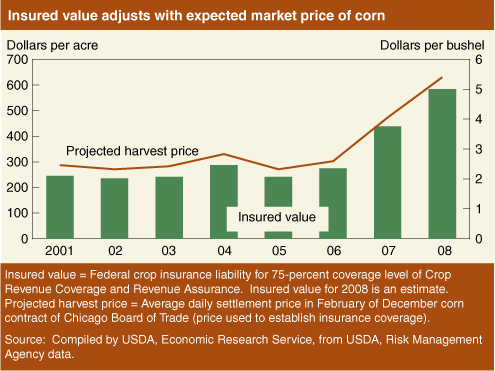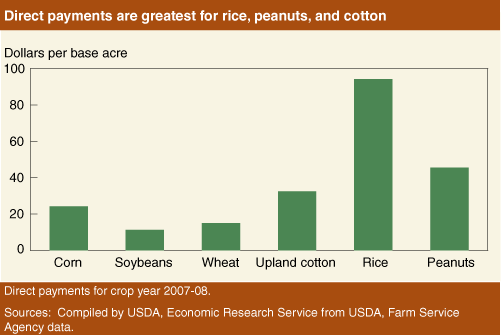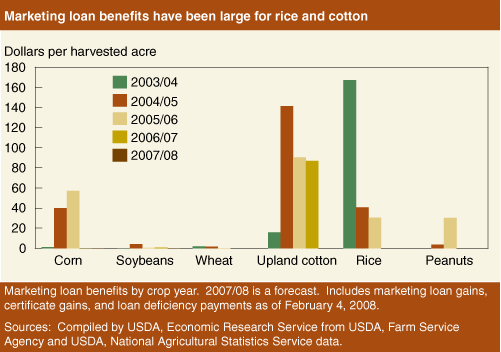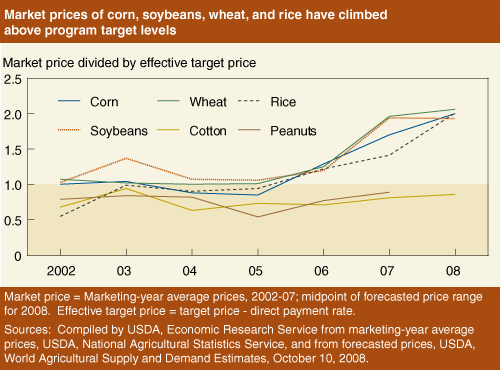New Market Realities Affect Crop Program Choices
- by Robert Dismukes and Edwin Young
- 11/1/2008
Highlights
- Even as farmers enjoy record-high commodity prices and income, they face an array of risks, including high production costs and greater price volatility.
- Rising crop prices lead to increased Federal crop insurance coverage but reduce the likelihood of commodity program payments based on fixed target prices.
- The new ACRE program offers revenue protection based on recent market prices, but participating farmers must forgo some benefits of traditional commodity programs.
Higher world market prices for major food commodities such as grains and vegetable oils have increased prices received by producers of several major field crops to historic highs—more than 75 percent above levels just 2 years ago (see, “Fluctuating Food Commodity Prices—A Complex Issue With No Easy Answers”). While price increases have boosted crop revenues and farm incomes, producers still face financial risks. For one, higher production costs—for fuel, seed, fertilizer, and land, in particular—have offset some of the gains in product prices and increased producers’ exposure to revenue losses. Higher prices have generally been accompanied by greater price volatility, increasing the costs of managing crop price risks. Prices might, as they generally have in the past after dramatic upswings, drop back to pre-spike levels. Finally, weather variability, as always, makes yields uncertain.
Farmers and ranchers employ a variety of tools and strategies—including forward contracting, diversification, savings/borrowing, and off-farm income—to mitigate and manage their risks. Field crop producers are also aided under government programs such as Federal crop insurance, disaster assistance, and commodity programs. The Food, Conservation, and Energy Act of 2008 (known as the Farm Act), which covers 2008-12, modifies these programs and adds new ones.
Crop Insurance: Coverage and Costs Adjust With Higher Crop Prices
Federally subsidized crop insurance, which includes a variety of crop yield and revenue insurance options, protects participating producers against risks over the growing season. Crop yield insurance protects against yield shortfalls; crop revenue insurance protects against revenue (yield multiplied by price) shortfalls. Both yield and revenue insurance adjust from year to year, depending on crop market price expectations. Since potential insurance payouts, as well as premium costs, increase with rising commodity prices, these insurance plans have assumed greater significance in the current price environment.
For example, assume that a corn producer’s expected yield, based on recent history, is 150 bushels per acre. If, prior to planting, the expected price of corn is $4 per bushel and the producer chooses the 75-percent coverage level, then the amount insured would be $450 per acre. If the expected price of corn rises 50 percent to $6 per bushel, and expected yield does not change, the producer’s insurance coverage would increase by the same percentage to $675 per acre. This increased revenue guarantee may be used to offset risks from higher input prices.
The most widely used insurance plans—which covered more than half of U.S. corn, soybean, wheat, and cotton acres in 2008—are revenue insurance plans that also provide increased amounts of insurance, within limits, if crop prices rise over the growing season. One example is Revenue Assurance with the Harvest Price Option, offered in the major corn and soybean States. Under this plan, the projected harvest price used in the revenue guarantee for corn is the average of the daily settlement prices during February of the December Chicago Board of Trade corn futures contract (the price of a contract purchased in February for delivery in December). The actual harvest price is determined from the November average of that contract. The revenue guarantee for the crop uses the higher of these two prices, although regulations stipulate that the harvest price that is used cannot be greater than 200 percent of the projected price.
Crop yield insurance policies, the second most widely used type of insurance, also use expected market prices to establish the insured values of crops. These expected prices, however, are determined differently than those used with revenue insurance, and they do not change over the growing season. Each year, prior to the crop insurance enrollment period, USDA’s Risk Management Agency (RMA) uses forecast season-average crop prices to set the prices at which yield losses would be paid. These prices, called “price elections,” together with expected yields and coverage levels, determine the insured value of the crops covered by yield insurance.
Increases in insurance amounts, the insured value of crops, lead, of course, to higher premium costs. This means that for the same coverage level, expressed as a share of the expected yield or revenue, expenditures for insurance go up. For example, at the 75-percent coverage level, if the premium rate is 5 percent and the amount of the insurance guarantee is $450 when the price of corn is $4 per bushel, then the premium cost is $22.50 per acre. The premium rises to $33.75 if the price of corn is $6 per bushel and the amount of the guarantee is $675 per bushel. The $225 increase in the amount of insurance costs an additional $11.25 in premium, if premium rates do not change. But, premium rates for revenue insurance can increase when crop prices go up because price risk or volatility, which is part of revenue risk, usually increases when price levels increase. The amount of the premium increase depends on the size of the increase in price volatility and the size of the price risk relative to the yield risk.
Both producers and the government pay more when crop insurance costs increase. Premiums on crop insurance policies are subsidized by the Federal Government. The subsidy rate depends on the coverage level and insurance plan selected by the producer. For the most popular insurance plans and coverage level—individual farm revenue at 75-percent coverage—the premium subsidy is 55 percent, meaning that producers pay 45 percent of the premium cost. For the entire crop insurance program, the government pays about 60 percent of total premiums. Thus, rising crop prices mean higher insurance program costs for the government. Premium subsidies increased from $2.3 billion in 2005 to $3.8 billion in 2007 and are expected be even higher in 2008, due largely to crop price increases.
Higher premiums also lead to increases in costs of other crop insurance program subsidies. For instance, administrative and operating subsidies, which are paid by the government to insurance companies for selling and servicing crop insurance policies, are determined from premium values. When premium amounts go up, so do administrative and operating subsidies. In order to trim insurance program costs, the 2008 Farm Act made small reductions in premium subsidy rates for area yield and revenue plans and in administrative and operating subsidy rates.
Disaster Assistance Payments Add to the “Safety Net” for Producers
While subsidized crop insurance is the primary form of assistance provided by the Federal Government against bad weather, plant diseases, and other natural hazards, ad hoc disaster assistance payments have also been frequently provided. Between 2000 and 2007, four disaster programs were authorized, at a total cost of about $10 billion. The 2008 Farm Act established a permanent Supplemental Agricultural Disaster Assistance program, which includes programs for livestock as well as crop producers.
The program for crop producers, called Supplemental Revenue Assistance (SURE), is linked to crop insurance. To be eligible for SURE payments, a producer, with some exceptions, is required to obtain crop insurance or, if crop insurance is not available, to participate in the Non-Insured Acreage Program (NAP). The SURE guarantee level is based on the producer’s insurance coverage: the higher the insurance level, the greater the SURE guarantee, up to 90 percent of the expected revenue.
Eligible producers in counties declared disaster counties by the Secretary of Agriculture, or in contiguous counties, or those who show proof of an individual loss of at least 50 percent are eligible to receive SURE payments for crop production or crop quality losses. Losses are measured considering whole-farm revenue, which includes crop insurance indemnities and commodity program payments, so that producers are not paid more than once for the same loss.
Traditional Commodity Programs Grow Less Important With Rising Prices
The commodity programs—direct payment, nonrecourse loan, and countercyclical payment (see box, “Traditional Commodity Programs and the 2008 Farm Act”)—provide benefits to field crop producers through income and product price supports. While each of these programs provides different benefits, all use payment triggers or rates that are set by legislation and do not adjust when market prices rise. Thus, these programs become less relevant as risk management tools when high prices prevail, and none provide protection against yield risks.
The 2008 Farm Act reauthorized, with some modifications, all three programs. Direct payments are fixed payments that do not vary with changes in crop prices or yields, and thus provide producers with steady, certain income. They are based on historical production and are made at payment rates, which are specified in legislation and vary by crop, with the largest per acre payments for rice, peanuts, and cotton. The nonrecourse loan and countercyclical payment programs provide benefits to producers when market prices drop below statutory trigger levels, called loan rates and effective target prices, which vary from crop to crop. Loan rates and effective target prices are specified in legislation and do not adjust with changes in market prices.
Commodity loans allow producers of designated crops to receive a loan from the government at a commodity-specific loan rate per unit of production by pledging the crop as loan collateral. The loans provide an effective price floor for participating producers. Because loan program benefits depend on actual production, they protect against price risk but not yield risk. Marketing loan benefits have been large for cotton since the 2003-04 crop year when market prices dropped below the loan rate.
Counter-cyclical payments (CCPs) provide an additional level of price-based income support. CCPs are designed to support and stabilize incomes when commodity prices are less than effective target prices. The effective target price for a crop is the target price established by legislation minus its direct payment rate. The payment rate is the difference between the effective target price and the market price or the loan rate, whichever is higher.
CCPs, because they are triggered by declines in prices, provide some price risk protection to producers growing the same crops they have produced historically or other crops whose prices closely track the CCP program crops. However, because CCPs are paid on historical, not current, production, they provide little protection from yield risk. In fact, if a producer has a yield loss in the same year that many others do and the market price of the crop goes higher than the CCP trigger level, there would be no CCP.
New ACRE Program Pegs Protection to Recent Market Prices
The 2008 Farm Act introduced an alternative to traditional commodity programs. The Average Crop Revenue Election Program (ACRE) is novel in that it protects against revenue (national price multiplied by State yield), rather than price, shortfalls and that it uses moving averages of market prices, instead of legislated target prices, to set levels of protection. By incorporating yield risk and by using recent market prices, ACRE could be an attractive alternative for producers in areas of high yield risk and for crops with market prices well above the trigger levels of traditional commodity programs. The choice, however, will not be simple.
The ACRE alternative will first be available in crop year 2009. To be eligible for ACRE payments, producers must elect the ACRE program for the farm, and then annually enroll in ACRE during the signup period announced by USDA’s Farm Service Agency. Although an ACRE signup period will occur each year, once a producer chooses ACRE, the decision holds for the remaining years covered by the 2008 Farm Act, that is, through crop year 2012. Enrollment in ACRE applies to all covered commodities and peanuts on the farm. Covered commodities are wheat, corn, barley, grain sorghum, oats, upland cotton, medium- and long-grain rice, oilseeds, and pulse crops (small and large chickpeas, dry beans, and lentils). Producers choosing ACRE will not be eligible for price-based CCPs, will give up 20 percent of their direct payments, and will have their nonrecourse loan rate lowered by 30 percent.
ACRE also differs from traditional programs in that it has a double trigger: State- and farm-level revenue shortfalls are required for a producer to receive a payment. The payment rate for an ACRE crop is based on the difference between the State-level revenue guarantee and the actual State-level revenue.
The payment rate is applied to a portion (83.3 percent in 2009-11; 85 percent in 2012) of the farm’s acres of the crop multiplied by the ratio of the farm’s average yield to the State’s average yield. ACRE payments are based on planted rather than historical base acres, though the number of acres that receive an ACRE payment cannot exceed a farm’s total base acres. In short, ACRE payments are available to producers of a crop if the State-level actual revenue for that crop is below the State ACRE guarantee revenue (90 percent of the national price guarantee times the 5-year Olympic average State yield) and if a producer’s farm-level actual revenue falls below the farm level guarantee. The farm-level guarantee for a commodity equals the farm’s 5-year Olympic average yield times the national guarantee price plus any crop insurance premiums per acre paid by the producer on the farm.
Shifting Program Benefits and Crop Prices Require Complex Management Decisions
Recent upswings in market prices for farm commodities have affected the relative importance of different government programs for field crop producers. Programs such as Federal crop insurance and ACRE, which adjust coverage and payments to reflect recent market trends, are increasingly important to producers of crops whose prices have increased dramatically.
As a producer considers whether to enroll in ACRE, two factors will be especially important: how much government support from traditional programs will be relinquished and whether the producer’s expectations are for robust or weakening prices. Direct payments, 20 percent of which will be surrendered to enroll in ACRE, are large for peanuts, cotton, and rice relative to payments for other crops. Expected benefits or payments under traditional commodity programs, which are based on prices specified in legislation, are less likely to materialize for crops whose market prices have increased.
Not all crop prices have increased equally. The marketing-year average price of corn rose to $4.25 per bushel in 2007, about 80 percent higher than its 10-year average and well above its nonrecourse loan rate ($1.95) and 2007 target price ($2.63). Soybean and wheat prices have followed similar patterns, and prices for all three crops are expected to increase again in 2008. In contrast, the average price for upland cotton was 53.5 cents per pound in 2007, just 9 percent above its 10-year average, about equal to its loan rate of 52 cents, and below its 2007-crop target price of 72.4 cents.
But what if current high prices drop? How will benefits provided by the various programs change? A sharp drop in crop price over a single crop year could trigger revenue payments from crop revenue insurance and ACRE, depending on production levels. A more gradual downward trend in price would reduce the potential dollar amount of payments, though not necessarily the degree of risk protection, from these programs as they adjust to the market conditions. Moreover, if prices drop to pre-spike levels, then the traditional commodity programs that provide benefits when prices are below legislated targets would be more likely to provide price and income support to producers. In short, while prices for several field crops are at high levels, U.S. producers will face management decisions that are complex because of the variability of crop prices and the variety of farm program options.
This article is drawn from:
- Farm & Commodity Policy. (n.d.). U.S. Department of Agriculture, Economic Research Service.
You may also like:
- Risk Management. (n.d.). U.S. Department of Agriculture, Economic Research Service.
- Title I (Commodity Progams), Average Crop Revenue Election (ACRE) Program of the 2008 Farm Bill Side-by-Side Comparison . (2008). ERS. Provides income support, with new payment and eligibility limits, for wheat, feed grains, cotton, rice, oilseeds, and pulses through direct payments (except pulses), counter-cyclical payments, marketing loan assistance program, and new average crop revenue election payments. Adjusts sugar loan rates and adds program to use surplus sugar for bioenergy production. Revises dairy price support to operate with administered prices for manufactured products rather than fluid milk..
- Title XII (Crop Insurance) of the 2008 Farm Bill Side-by-Side Comparison. (2008). ERS. Reduces subsidies to insurance companies for selling and servicing crop insurance policies. Increases administrative fees paid by farmers for minimum insurance coverage level. Requires studies and adjustments to improve organic crop insurance coverage. Introduces Supplemental Agricultural Disaster Assistance Program that supplements crop insurance coverage and provides disaster assistance for livestock (including aquaculture and honey bees), forage, and tree and nursery crops..





